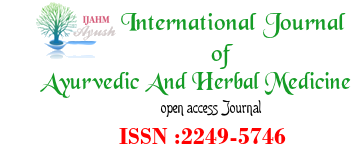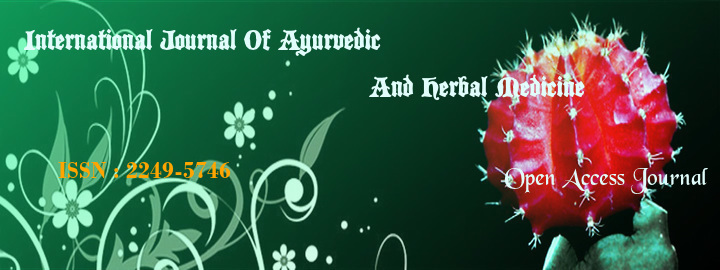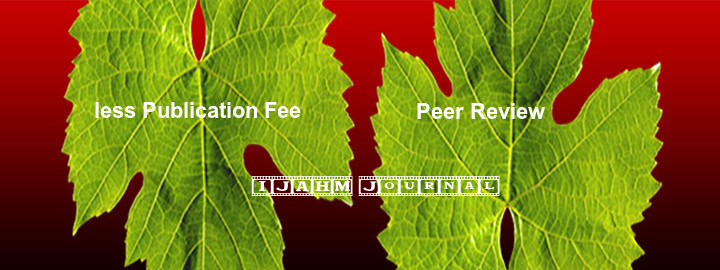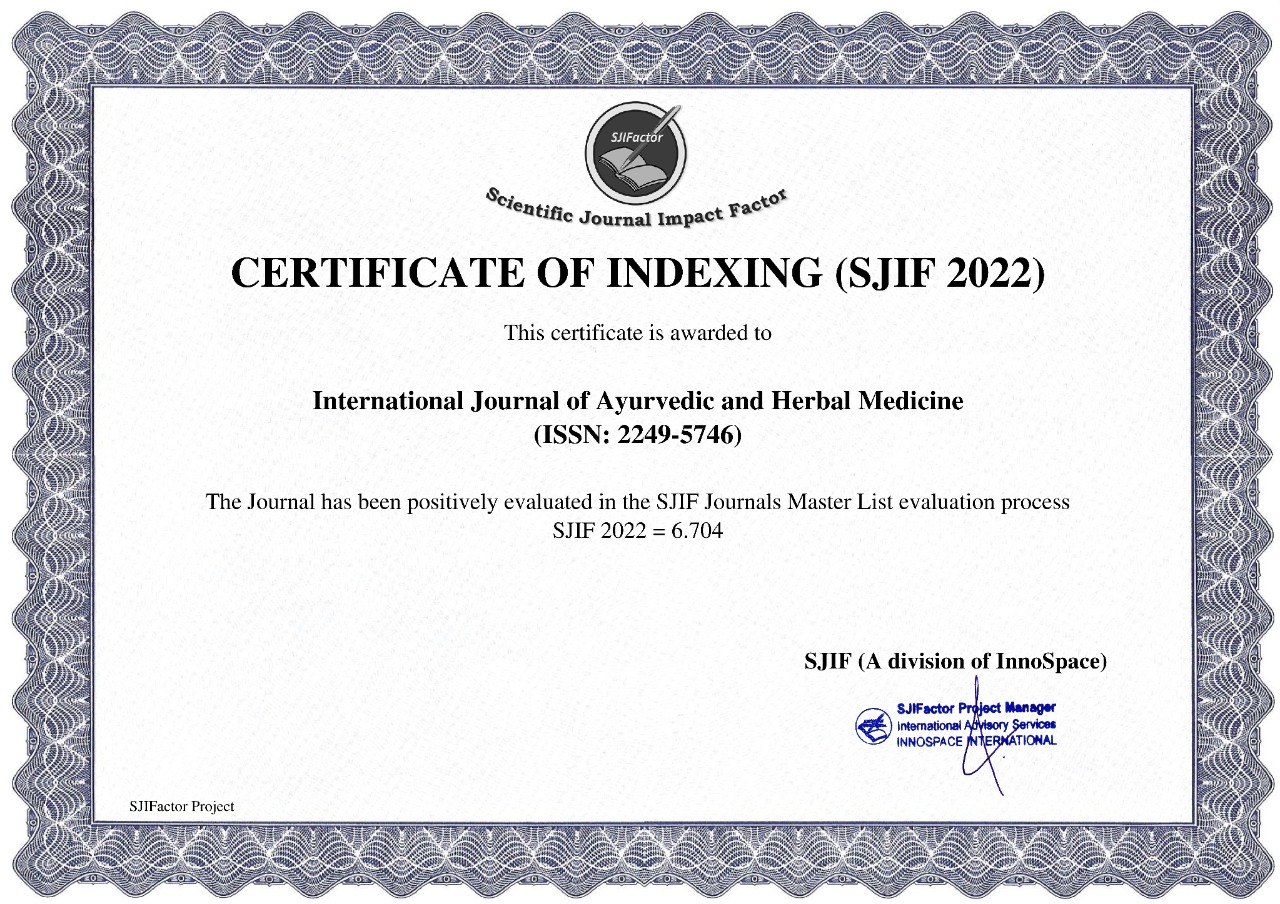


Kulkarni D. Dattatraya ,Doddoli G. Suchitra , Bhogal S. Ranjit
DOI : http://dx.doi.org/10.31142/ijahm/v9i1.03
1Research Officer, Scientific Research Department, Kaivalyadhama S.M.Y.M. Samiti, Lonavla, Pune, Maharashtra, India.
2Research Assistant, Scientific Research Department, Kaivalyadhama, S.M.Y.M. Samiti, Lonavla, Dist. Pune, Maharashtra, India.
3Assistant Director of Research, Scientific Research Department, Kaivalyadhama S.M.Y.M. Samiti, Lonavla, Pune, Maharashtra, India
ABSTRACT-
The comparison of diagnostic approach between modern medicine and traditional holistic health care systems namely Ayurveda, Yoga, Unani, Siddha and Homeopathy (AYUSH) has been a subject of research interest. However, the precision and accuracy of physicians’ diagnostic skill in AYUSH mainly acquired through clinical experience wherein, inter-rater reliability and consistency of same seems skeptical.
The present diagnostic research scenario of AYUSH reflects lack of consistency and reliability that hints for barring of physicians’ diagnostic cognitive assessment. Therefore, this study advocates neuropsychological approach of Human Information Processing (HIP) model applicable to both physicians’ cortical diagnostic cognition function and subjects’ symptom generation. The study proposes modulation of bioelectrical activity on electro-neuro-physiological domain of physicians’ cortical HIP function based on signal detection theory (SDT).
The traditional yoga and meditation practices would improve quality of physicians’ diagnosis through electro cortical phase analysis to perceive subjects’ whole body bioelectrical activity of symptom generation. Henceforth, the study concludes yoga and meditation practice modulates HIP-SDT axis to enhance physicians’ diagnostic skill performance.
Key words: AYUSH, Yoga, Meditation, HIP, SDT
References:
1. Kulkarni DD, Doddoli GS, Shete US, Verma A, Bhogal SR. A Bio-Electrical Model for Physiological Evaluation of Nadi Pariksha (Ayurvedic Pulse Diagnosis). Int j Ayurveda Pharma res 2014; 2(4):25-31.
2. Lampe PD, Lau AF. Regulation of gap junctions by phosphorylation of connexins. Arch Biochem Biophys 2000; 384(2):205-215.
3. Lampe PD, Lau AF. The effects of connexin phosphorylation on gap junctional communication. Int J Biochem Cell Biol 2004; 36(7):1171-1186.
4. Glodstien K, Scheerer M. Abstraction and Concrete behavior: An experimental study with special tests. Psychol Monogr 1941; 53(2):i-151.
5. Van den Heuvel MP, Sporns O. Network hubs in the human brain. Trends Cogn Sci 2013; 17(12):683–696.
6. Power JD, Schlaggar BL, Lessov-Schlaggar CN, Petersen SE. Evidence for Hubs in Human Functional Brain Networks. Neuron 2013; 79(4):798–813.
7. Adam Zeman. Consciousness. Brain 2001; 124(7):1263-1289.
8. Kafri O. Information theoretic approach to social networks. arXiv: 1407.7964. 2014.
9. Green DM, Swets JA. Signal Detection Theory and Psycho physics. Wiley, London, 1966a.
10. Robert A. Mind, Body and Immune Response. Psychoneuroimmunology, Elsevier Academic Press, London, 1981, 609-617.
11. Kulkarni DD. Yoga and Neuropsychology. Yoga –Mimamsa 1997; 32(1&2):48-59.
12. Kulkarni DD. Understanding HIP of Yoga Practice Effects: A Neuropsychological Approach. Yoga-Mimamsa 2011; 53(2):152-164.
13. Hillyard SA, Terence WP, Regan D. Event Related Brain Potentials in Man. In Sensation, Perception and Attention. Callaway E, Teuting P, Koslow S (Eds.). Elsevier, Netherlands, 1978, 223-347.
14. Manasi S, Raju KV. Holistic approach to improve community health - The AYUSH approach. Journal of Holistic Healthcare 2015; 12(2):33-38.
15. Patwardhan B. National health policy: Need to innovate. J Ayurveda Integr Med 2015; 6(1):1–3.
16. Macdonald H, Loder E. Too much medicine: the challenge of finding common ground. BMJ 2015; 350:h1163.
17. Gadre A. India’s private healthcare sector treats patients as revenue generators. BMJ 2015; 350:h826.
18. Shukla V, Tripathi RD. Charaka Samhita, Sutra Sthana. Chaukhamba Sanskrit Pratishthan, Delhi 2003, 292.
19. Berent GR, Zeck JM, Leischner JA, Berent EA. Yoga as an alternative intervention for promoting a healthy lifestyle among college students. J Addict Nurs 2014; 25(4):167-171.
20. Swami M, Kulkarni DD. Review of Psycho-physiological studies on respiration for future research in Pranayama. Scientific Exposition on Pranayama. Arogyadham (Kaivalyadham) publisher, Rajasthan, India, 2012, 233-241.
21. Shiffrin RM, Schneider W. Automatic and controlled processing revisited. Psychol Rev 1984; 91(2):269-276.
22. Cowan, N. Evolving conception of memory storage, selective attention and their mutual constraints within the human information processing system. Psychol Bull 1988; 104(2):161-191.
23. Hillyard SA, Terence WP, Regan D. Event Related Potentials in Man. In Sensation, Perception and attention: Analysis using ERPs. Callaway E, Teuting P, Koslow S (Eds.). Academic Press, New York, 1978, 223-322.
24. Grand Perrire A. Fundamental complexity measures of Life. In Divine action and Natural Selection: Questions of Science and Faith in Biological Evolution. Seckbach J, Gordon R (Eds.). World Scientific, Singapore, 2008, 566-615.
25. Grand Perrire A, Kafatos M. Biological Autonomy. Philosophy Study 2012; 2(9):631-649.
26. João L, Garcia R. Biologically Plausible Artificial Neural Networks. In Artificial Neural Networks - Architectures and Applications. Suzuki K (Ed.). In Tech Publisher, 2013, ISBN: 978-953-51-0935-8.
27. Shanon CE, Weaver W. The Mathematical Theory of Communication. University of Illinoise press, Urbana and Chicago, 1964.
28. Noma E, Biard JC. Fundamentals of psychophysical Scaling. Wiley, New York, 1976.
29. Green DM, Swets JA. Sensory Process in Detection- Part II – Theory of Ideal Observer. In Signal Detection Theory and Psycho physics, Wiley, London, 1966b, 152-179.
30. Amato F, López A, Peña-Méndez EM, Vaňhara P, Hamp A et al. Artificial neural networks in medical diagnosis. J Appl Biomed 2013; 11(2):47–58.
31. Khan IY, Zope PH, Suralkar SR. Importance of Artificial Neural Network in Medical Diagnosis disease like acute nephritis disease and heart disease. International Journal of Engineering Science and Innovative Technology 2013; 2(2):210-217.
32. Atasoy S, Donnelly I, Pearson J. Human brain networks function in connectome-specific harmonic waves. Nat Commun 2016; 7(4):10340.
33. Müller MJ, Bosy-Westphal A, Later W, Haas V, Heller M. Functional body composition: insights into the regulation of energy metabolism and some clinical applications. Eur J Clin Nutr 2009; 63(9):1045–1056.
34. Yerkes RM, Dodson JD. The Relation of Strength of Stimulus to Rapidity of Habit-Formation. J Comp Neurol Psychol1908; 18(5):459-482.
35. Norman K, Wirth R, Neubauer M, Eckardt R, Stobäus N. The bio-impedance phase angle predicts low muscle strength, impaired quality of life, and increased mortality in old patients with cancer. J Am Med Dir Assoc 2015; 16(2):173.
36. Kulkarni DD, Doddoli SG, Bhogal RS. Effect of Yoga training on Bio-energy dynamics with reference to Bioelectrical Impedance and Tridosha in Dominant Nostril Breathing Types – A pilot study, International Journal of Innovative and Applied Research 2015; 3(10):47- 58.
37. Kandel ER, James HS, Siegelbaum AS. The Auditory Central Nervous System. In Principles of Neural Science. Edn 5, Part V, Elsevier, Amsterdam, 2013a, 695-697.
38. Kandel ER, James HS, Siegelbaum AS. The Control of Gaze. In Principles of Neural Science. Edn 5, Part VI, Elsevier, Amsterdam, 2013b, 906-911.
39. Green DM, Swets JA. Comparison of Ideal and Human Observers. In Signal Detection Theory and Psycho physics, Wiley, London, 1966c, 180-208.
40. Pachauri N, Mishra D. Phase Synchronization and Coherence Analysis between ECG & Arterial Blood Pressure. Int J Comput Appl 2012; 44(18):27-30.
41. Hu S, Chi J, Zhang J, Kong W, Cao Y, He B. Increase trend of correlation and phase synchrony of microwire I EEG before macroseizure onset. Cogn Neurodyn 2014; 8(2): 111–126.
42. Dumermuth G, Lehman D. EEG Power and Coherence During non-REM and REM Phases in human in all night sleep analysis. Euro Neural 1981; 20(6):429-434.
43. Mölle M, Marshall L, Gais S, Born J. Learning increases human electroencephalographic coherence during subsequent slow sleep oscillations. Proc Natl Acad Sci USA 2004; 101(38):13963-13968.
44. Kulkarni DD. Orienting Reflex In Shavasana Practice and Shavasana Imagery, Yoga-Mimamsa 1998; 34(1):27-36.
45. Kulkarni DD, Bhogal RS. (1991a). Coping Anxiety throughthe yogic corpse posture: Shavasana- A Signal Detection Theory Approach. Paper presented at the Souvenir, XII International Conference of STAR, University of Hungary, Budapest, 77-78.
46. Kulkarni DD, Bhogal RS. (1991b). Role of Shavasana in Parallel Vigilance in Aeropspace operations. Paper presented at the International conference in Stress, Anxiety and Emotions, University De-Minho, Braga, Portugal. July.
47. Kulkarni DD. Orienting Reflex in Shavasana practice and Shavasana Actual Imagery- A Comparative Study. Yoga-Mimamsa 2002; 54 (1):27-36.
48. Kulkarni DD. Effect of Shavasana Practice on Resource Conservation and Stimulus Evaluation. Yoga Mimamsa 2003; 36(3&4):214-223.
49. Kulkarni DD, Bera TK. Yogic exercises and health – a psycho-neuro-immunological approach. Indian J Physiol Pharmacol 2009; 53 (1):3–15
50. Grimnes S. Electro vibration, cutaneous sensation of microampere current. Acta physiol Scand 1983; 118(1):19-25.
51. Grimnes S, Martinson OG. Bioimpedance and Bioelectricity Basics, Edn 2, Academic Press, 2008.
52. Ursula GK, Ingvar B, De Lorenzo AD, Deurenberg P, Elia M, Jose MG et al. Bioelectrical impedance analysis part I: review of principles and methods. Clin Nutr 2004; 23(5):1226–1243.
53. Hills A, Byrne N. Bioelectrical impedance and body composition assessment. Malays J Nutr 1998; 4(1):107-112.
54. De Oliveira PG, dos Santos ASP, de Mello ED. Bioelectrical impedance phase angle: utility in clinical practice. Int J Nutrology 2012; 5(3):123-127
55. Duncan-Johnson CC, Donchin E. The P300 component of the event related potentials as an index of information processing. Biol Psycho 1982; 14(1-2):1-52.
56. Callaway E, Tueting P, Koslow S. Event Related Brain Potentials in Man. Academic press, London, 1978.
57. Gothe N, Pontefex MB, Hillman C, McAuley E. The Acute Effects of Yoga on Executive Function. J Phys Act Health 2013; 10(4):488-495.
58. Kulkarni DD, Shete SU, Thakur GS. Immediate effect of Shavasana on bio-electric Voltage Phase Shift: A Pilot Study. Paper presented at the 7th International Conference Yoga for Youth: Classical and Complimentary Perspectives, Kaivalyadhama, Lonavla, India, 2012, 43-44.
59. Thatcher RW, North D, Biver C. Self-organized criticality and the development of EEG phase reset. Hum Brain Mapp 2009a; 30(2):553-574.
60. Thatcher RW, North D, Biver C. Development of cortical connectivity as measured by EEG coherence and phase. Hum Brain Mapp 2008; 29(12):1400-1415.
61. Thatcher RW, North D, Neurbrander J, Biver CJ, Cutler S, DeFina P. Autism and EEG phase reset: Deficient GABA mediated inhibition in thalamo-cortical circuits. Dev Neuropsych 2009b; 34(6):780–800.
62. Loney, JW. An ECG/EEG common mode rejection ratio analyzer. J Clin Eng 1982; 7(4):309-312.
63. Fleming SM, Weil RS, Nagy Z, Dolan RJ, Rees G. Relating Introspective Accuracy to Individual Differences in Brain Structure. Science 2010; 329(5998):1541-1543.
64. Ganpat TS, Nagendra HR, Muralidhar K. Effects of yoga on brain wave coherence in executives. Indian J Physiol Pharmacol 2011; 55(4):304–308.
65. Lazar SW, Kerr CE, Wasserman RH, Gray JR, Greve DN, Treadway MT et al. Meditation experience is associated with increased cortical thickness. Neuroreport 2005; 16(17):1893–1897.
index






















